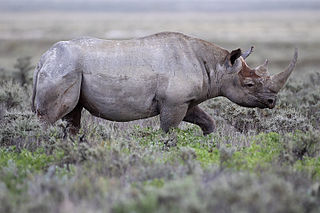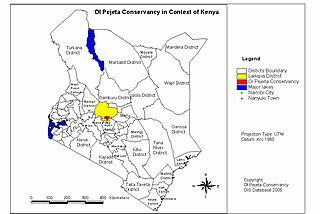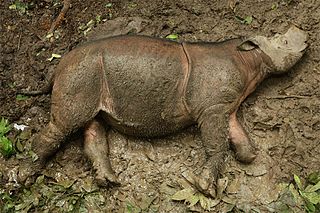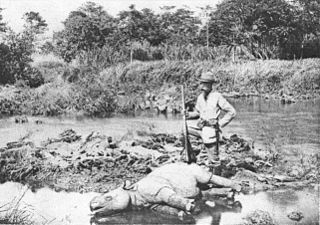Related Research Articles

Poaching is the illegal hunting or capturing of wild animals, usually associated with land use rights. Poaching was once performed by impoverished peasants for subsistence purposes and to supplement meager diets. It was set against the hunting privileges of nobility and territorial rulers.

Kruger National Park is a South African National Park and one of the largest game reserves in Africa. It covers an area of 19,623 km2 (7,576 sq mi) in the provinces of Limpopo and Mpumalanga in northeastern South Africa, and extends 360 km (220 mi) from north to south and 65 km (40 mi) from east to west. The administrative headquarters are in Skukuza. Areas of the park were first protected by the government of the South African Republic in 1898, and it became South Africa's first national park in 1926.

The black rhinoceros, black rhino or hook-lipped rhinoceros is a species of rhinoceros, native to eastern and southern Africa including Angola, Botswana, Kenya, Malawi, Mozambique, Namibia, South Africa, Eswatini, Tanzania, Zambia, and Zimbabwe. Although the species is referred to as black, its colours vary from brown to grey. It is the only extant species of the genus Diceros.

A police dog is a dog that is trained to assist police and other law enforcement officers, search and rescue, or the military. Their duties may include searching for drugs and explosives, locating missing people, finding crime scene evidence, protecting officers and other people, and attacking suspects who flee from officers. The breeds most commonly used by law enforcement are the German Shepherd, Belgian Malinois, Bloodhound, Dutch Shepherd, and Labrador Retriever. In recent years, the Belgian Malinois has become the leading choice for police and military work due to their intense drive, focus, agility, and smaller size, though German Shepherds remain the breed most associated with law enforcement.

The Belgian Shepherd is a breed of medium-sized herding dog from Belgium. While predominantly considered a single breed, it is bred in four distinct varieties based on coat type and colour; the long-haired black Groenendael, the rough-haired fawn Laekenois, the short-haired fawn Malinois, and the long-haired fawn Tervuren. In the United States, the American Kennel Club considers the four varieties to be separate breeds.

Hluhluwe–Imfolozi Park, formerly Hluhluwe–Umfolozi Game Reserve, is the oldest proclaimed nature reserve in Africa. It consists of 960 km² of hilly topography 280 kilometres (170 mi) north of Durban in central KwaZulu-Natal, South Africa and is known for its rich wildlife and conservation efforts. Operated by Ezemvelo KZN Wildlife, the park is the only state-run park in KwaZulu-Natal where each of the big five game animals can be found.

The PDSA Dickin Medal was instituted in 1943 in the United Kingdom by Maria Dickin to honour the work of animals in World War II. It is a bronze medallion, bearing the words "For Gallantry" and "We Also Serve" within a laurel wreath, carried on a ribbon of striped green, dark brown, and pale blue. It is awarded to animals that have displayed "conspicuous gallantry or devotion to duty while serving or associated with any branch of the Armed Forces or Civil Defence Units". The award is commonly referred to as "the animals' Victoria Cross".

A rhinoceros, commonly abbreviated to rhino, is a member of any of the five extant species of odd-toed ungulates in the family Rhinocerotidae. Two of the extant species are native to Africa, and three to South and Southeast Asia.

The Indian rhinoceros, or Indian rhino for short, also known as the greater one-horned rhinoceros or great Indian rhinoceros, is a rhinoceros species native to the Indian subcontinent. It is listed as Vulnerable on the IUCN Red List, as populations are fragmented and restricted to less than 20,000 km2 (7,700 sq mi). Moreover, the extent and quality of the rhino's most important habitat, the alluvial Terai-Duar savanna and grasslands and riverine forest, is considered to be in decline due to human and livestock encroachment. As of August 2018, the global population was estimated to comprise 3,588 individuals, including 2,939 individuals in India and 649 in Nepal. Kaziranga National Park alone had an estimated population of 2,048 rhinos in 2009. Pobitora Wildlife Sanctuary in Assam has the highest density of Indian rhinos in the world with 84 individuals in an area of 38.80 km2 (14.98 sq mi) in 2009.

The white rhinoceros, white rhino or square-lipped rhinoceros is the largest extant species of rhinoceros. It has a wide mouth used for grazing and is the most social of all rhino species. The white rhinoceros consists of two subspecies: the southern white rhinoceros, with an estimated 15,942 wild-living animals in the year 2018, and the much rarer northern white rhinoceros. The northern subspecies has very few remaining individuals, with only two confirmed left in 2018, both in captivity. Sudan, the world's last known male Northern white rhinoceros, died in Kenya on 19 March 2018 at age 45.

The PDSA Gold Medal is an animal bravery award that acknowledges the bravery and devotion to duty of animals. It was created by the People's Dispensary for Sick Animals (PDSA) in 2001, and is now recognised as the animal equivalent of the George Cross. The Gold Medal is considered as the civilian equivalent to PDSA's Dickin Medal for military animals. An animal can be awarded the PDSA Gold Medal if it assists in saving human or non-human life when its own life is in danger or through exceptional devotion to duty. The medal can also be awarded to animals in public service, such as police or rescue dogs, if the animal dies or suffers serious injury while carrying out its official duties in the face of armed and violent opposition.

The International Rhino Foundation (IRF) is a Texas-based charity focused on the conservation of the five species of rhinoceros: the White Rhinoceros and Black Rhinoceros in Africa, and the Indian Rhinoceros, Javan Rhinoceros and Sumatran Rhinoceros in Asia.
The Kruger National Park is a South African National Park and one of the largest game reserves in Africa. Originally known as The Sabi Game Reserve, it became a game reserve in 1898. The park became known as Kruger National Park in 1926, when it was named after Paul Kruger.

The Ol Pejeta Conservancy is a 360 km2 (140 sq mi) not-for-profit wildlife conservancy in Central Kenya's Laikipia County. It is situated on the equator west of Nanyuki, between the foothills of the Aberdares and Mount Kenya. The Ol Pejeta Conservancy works to conserve wildlife, provide a sanctuary for great apes, and generate income through wildlife tourism and complementary enterprises for re-investment in conservation and community development.

Rhino poaching in Assam is one of the major environmental issues in India which continues in the region of Kaziranga National Park, Manas National Park and some other grasslands of Assam. Indian rhinos inhabited most of the floodplain of the Indogangetic and Brahmaputra riverine tracts and the neighboring foothills.

The Bornean rhinoceros, also known as the eastern Sumatran rhinoceros or eastern hairy rhinoceros, is one of three subspecies of Sumatran rhinoceros. The subspecies may be functionally extinct, with only one individual, a female named Pahu, surviving in captivity, and held in the state of Sabah. In April 2015, the Malaysian government declared the Bornean rhinoceros to be extinct in the wild in the Malaysian portion of Borneo. However, in March 2016, a young female rhino was captured in East Kalimantan, providing evidence of their continued existence. The International Union for Conservation of Nature (IUCN) classifies the subspecies as critically endangered.

Lucca was a German Shepherd/Belgian Malinois service dog who was employed by the United States Marine Corps for 6 years. She was trained to detect explosives. She was deployed twice to Iraq and once to Afghanistan. In her over 400 missions, no human fatalities occurred under her watch. In 2012, while on patrol in Afghanistan, she was injured by an IED blast, necessitating the amputation of her left leg. After recovering at Camp Pendleton, Lucca officially retired in 2012 and was adopted by her original handler, Gunnery Sergeant Chris Willingham.

The wildlife trafficking network in southern Africa involves the illicit extraction, transportation and transaction of wildlife within and across the nations of Botswana, Lesotho, Namibia, South Africa and Eswatini. Involvement in the illegal trading network can be divided into three general roles: poachers, traffickers and intermediaries, and consumers. There are a wide range of motives depending on an individual's role in the network. Some motivations include profit, sustenance, and reducing human-wildlife conflict.

Rhinoceros poaching in southern Africa is the illegal act of slaughtering rhinoceros in the southern African countries of Namibia, Botswana, Zimbabwe and South Africa, where most of Africa's rhinos occur. The most common reason for rhino poaching is to meet the high demand for their horns in Asian countries, where the horn is predominantly used in Traditional Chinese Medicine but is increasingly being used as a symbol of wealth and prosperity. In previous generations, the most common rhino poaching activity was hunting for recreational purposes. Because of excessive poaching, rhino populations have decline rapidly since the 1970s, leaving some species critically endangered and facing extinction.
Hemmersbach Rhino Force is a direct action conservation organization acting with a focus on the African rhinos. Rhino Force's main activities consist of anti-poaching rangers in the Greater Kruger National Park, a biobank called Hemmersbach Rhino Force Cryovault to preserve rhino genes and the Black Rhino Reintroduction to bring back rhinos to the Mid Zambezi Valley in Zimbabwe.
References
- ↑ "Supreme honour for South Africa's most successful poacher-hunting dog". PDSA. 7 January 2016. Archived from the original on 29 January 2016. Retrieved 10 January 2016.
- ↑ Smith, Sam. "South Africa's K9 Killer receives highest PDSA honour for saving rhino". Traveller24. News24. Retrieved 13 January 2016.
- ↑ Grant, Katie (7 January 2016). "K9 Killer: Dog receives PDSA Gold Medal for helping to save rhino from extinction". The Independent . The Independent.
- ↑ "Minister Edna Molewa highlights progress in the fight against rhino poaching". environmental affairs. 21 January 2016. Retrieved 16 October 2018.
- 1 2 "Rhino poacher- hunting dog from South Africa gets hero medal". BBC News . 8 January 2016.
- ↑ "Famous Anti-Poaching Hero Dog, K9 Killer, Sadly Passes Away After Long Illness". 5 June 2020.
- ↑ "FAQs – ABMC". www.malinoisclub.com. Retrieved 25 October 2018.
- 1 2 "Dog trainer testifies about Killer in court | Lowvelder". Lowvelder. 27 June 2014. Retrieved 19 October 2018.
- ↑ Martin, Guy (28 March 2017). "Anti-poaching dogs a game-changer for Kruger | defenceWeb". www.defenceweb.co.za. Retrieved 19 October 2018.
- 1 2 "Poacher-hunting dog gets hero medal". BBC News. 2016. Retrieved 21 October 2018.